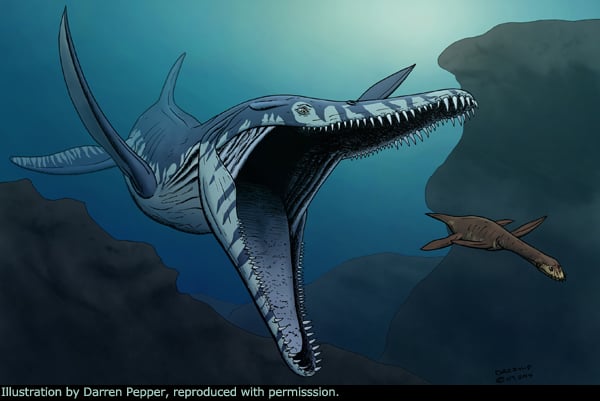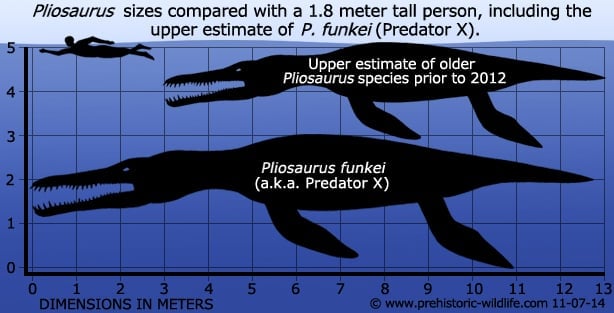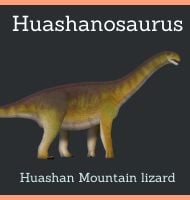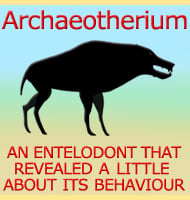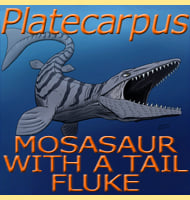In Depth
Originally described as a species of Plesiosaurus, this was the first pliosaur ever named which is why Pliosaurus is used as the type genus of the Pliosauridae. Related to the long necked plesiosaurs the pliosaurs adapted to fill a range of different predatory niches with some like Pliosaurus itself being hunters of other marine reptiles. Such prey preference is indicated by the large teeth as much as thirty centimetres long and jaws which would have been okay on small prey like fish, but devastating against large prey like plesiosaurs, ichthyosaurs, smaller pliosaurs and quite possibly giant fish such as Leedsichthys.
Because of its long history a large number of remains under many different species have been attributed to the genus, but the list of valid names has now been greatly reduced as a result of more intensive study of the fossils. The earlier attribution of fossils under multiple species names is known as the wastebasket effect, and is something that happened to almost all early discovered prehistoric creatures including the plesiosaur Plesiosaurus, the dinosaurs Megalosaurus and Iguanodon, as well as the pterosaurs Pterodactylus and Rhamphorhychus.Special note upon Pliosaurus funkei, a.k.a. Predator X.
In 2006 highly fragmentary remains of a marine reptile were found, and in 2008 an effort began to recover the fossils from the island of Spitsbergen in the Svalbard archipelago. These fragments numbered around 20,000 pieces in number, and took a long while to piece together, though like a 3D jigsaw, they slowly came together to form a particularly huge pliosaur that was subsequently dubbed ‘Predator X’. Predator X quickly caught the attention of the news and popular science media, and was even a focus animal in an episode of the well-made dinosaur documentary series Planet Dinosaur, and all before this individual had even been granted an official binomial name. Today, Predator X is known within scientific circles as Pliosaurus funkei which is the official descriptive name for this pliosaur that was granted in 2012.
When P. funkei was still only known as Predator X, it was initially thought to have possibly been as much as 15 meters long. Now that the fossils of this pliosaur have been reconstructed more, studied and identified as a species of Pliosaurus, more accurate reconstructions have now been put together. This has seen the speculated size of Predator X, now as Pliosaurus funkei, estimated at somewhere between 10 and 12.8 meters long. Unfortunately this revision has still gone unnoticed by some who still credit individuals as being 15 meters long, in a similar manner to how another pliosaur named Liopleurodon is still being credited as being 25 meters long by some even though the largest known specimen is a little over 6 meters in length.
At the time of writing the only known fossils of Pliosaurus funkei include a partial skull, a flipper and a few additional post cranial remains such as vertebrae. These remains are what were used to establish the new size ranges for this pliosaur, though it is quite conceivable that should a second specimen ever be found the size range may be revised to be smaller, or even a little larger to what it currently stands at. Even at ten meters long, however, P. funkei will still be comparable to other large species of Pliosaurus, as well as other large pliosaur genera such as Kronosaurus and Brachauchenius. Like with its relatives, individual P. funkei would have been specialised predators of other large marine organisms.
Further Reading
– Two new pliosaurs from the lower Volgian tier of the Volga region (right bank) – Doklady Akademii Nauk SSSR 60:115-118 – N. I. Novozhilov – 1948. – A review of Upper Jurassic pliosaurs – Bulletin of the British Museum (Natural History), Geology Series 14(5):147-189 – L. B. Tarlo – 1960. – A new species of Pliosaurus (Sauropterygia: Plesiosauria) from the Middle Volgian of central Spitsbergen, Norway – Norwegian Journal of Geology 92 (2–3): 235–258 – Espen M. Knutsen, Patrick S. Druckenmiller and J�rn H. Hurum – 2012. – A taxonomic revision of the genus Pliosaurus (Owen, 1841a) Owen, 1841b – Norwegian Journal of Geology 92 (2–3): 259–276. – Espen M. Knutsen – 2012. – A giant pliosaurid skull from the Late Jurassic of England – PLoS ONE 8(5) – R. B. J. Benson, M. Evans, A. S. Smith, J. Sassoon, S. Moore-Faye, H. F. Ketchum & R. Forrest – 2013. – A new species of Pliosaurus (Sauropterygia, Plesiosauria) from the Upper Jurassic of northwestern Patagonia, Argentina”. Ameghiniana. 51 (4): 269–283. – Z. Gasparini & J. O’Gorman – 2014. – A new Pliosaurus species (Sauropterygia, Plesiosauria) from the Upper Jurassic of Patagonia: new insights on the Tithonian morphological disparity of mandibular symphyseal morphology. Journal of Paleontology 92(2):240-253. – J. P. O’Gorman, Z. Gasparini & L. A. Spalletti – 2018.
